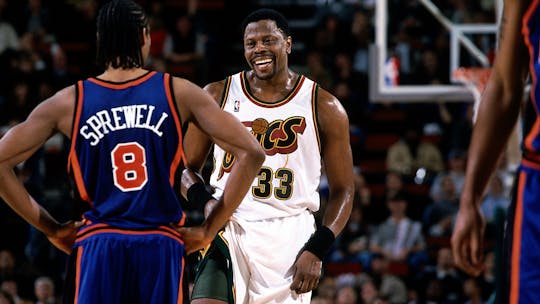Around this time of year, a thread on Twitter becomes like clockwork. In this pocket of time when baseball season is heading into overdrive, football season is about to come back, and basketball season is just around the corner, fans begin reminiscing.
There are no historical debates. No get-off-my-lawn, this-era-was-better talk. Just pure nostalgia about iconic players looking like they’ve been edited into a jersey they never wore. You get Manny Ramirez in Los Angeles Dodgers blue, Greg Maddux in Padres Navy, or Brett Favre in New York Jets Green.
In the following, we look at some of the most peculiar NBA examples and the stories behind these baffling career moves. The player empowerment era has emboldened fanbases to Photoshop stars io their favorite team’s colors. We promise none of these are fake.
Patrick Ewing - Seattle Supersonics (2000-2001), Orlando Magic (2001-2002)
Patrick Ewing isn't just a New York Knicks legend. He practically is New York basketball. When you think of the fabled Knicks squad of the ‘90s that battled Michael Jordan and the Bulls, Reggie Miller and the Pacers, or those Pat Riley-coached Miami Heat teams, you think of Ewing. You think of his dunks, his post moves, his deceptive outside shot, and his blocks. Heck, you can even imagine from memory how his entire face was covered in sweat during the fourth quarter.
However, Ewing doesn't have just one "fake jersey swap" but two! In 2000, at 38 years old, Ewing was part of a massive four-team trade involving the Knicks, Seattle Sonics, LA Lakers, and Detroit Pistons. A lot of names and a lot of picks were part of that trade, but the transactions really didn't have lasting impacts with either of the teams involved. A season later, Ewing joined the Orlando Magic where he eventually retired.
Twenty years after the Knicks-Sonics trade, seeing Ewing wearing anything but a New York jersey still seems weird. — Yoyo Sarmenta
Allen Iverson – Memphis Grizzlies (2009)

Remember when Carmelo Anthony, during his stint with the Oklahoma City Thunder, scoffed at the idea of coming off the bench? That was awfully reminiscent of Allen Iverson's three-game stint with the Memphis Grizzlies in 2009.
At that point in his career, Bubba Chuck had pretty much done it all – from revitalizing Philadelphia sports, playing in Denver, then getting unceremoniously traded to the Detroit Pistons midseason in a salary dump. At 34 years old, Iverson believed he still had what it took to contribute as a starter, so he signed a one-year deal with the Grizzlies in the 2009 offseason.
AI wound up playing just three road games for Memphis, all coming off the bench. He never played in Memphis. Iverson, who was the star on his team ever since he was in high school Virginia, just could not take a bench role. Memphis was then a rebuilding team trying to develop their young point guard Mike Conley. They might have seen Iverson as a mentor figure.
“I’ve never been a reserve all my life and I’m not going to start looking at myself as a reserve,” Iverson said then. “If we’re winning, I can play 10 minutes and I’m happy. When we’re losing, that’s when I trip out.”
He made an emotional return to Philadelphia later that season. The Answer played just 25 games for the Sixers that year but was still voted an All-Star by his legions of fans.
To this day, many still wonder how A.I. could have ended his career, had he accepted a bench role. Maybe we’re seeing it now with his former teammate in Carmelo Anthony. — Miguel Flores
Tony Parker - Charlotte Hornets (2018-2019)

Tony Parker spent 17 memorable years with the San Antonio Spurs. He won four championships, earned a Finals MVP, and became a six-time All-Star. The French point guard was part of the heralded Spurs Big 3 alongside Tim Duncan and Manu Ginobili. You can't talk about the Spurs dynasty without mentioning Parker.
And yet, in 2018, Parker signed with the Charlotte Hornets. The news of it seemed so bizarre that even the Spurs management initially didn't believe that TP would actually leave. But a dreaded quad injury the season before and the changing direction of the Spurs were among the reported reasons for him to leave San Antonio.
At age 36, Parker played 56 games for the Hornets averaging 9.5 points and 3.7 assists in a career-low 17.9 minutes per game. It's still disorienting and maybe even a little bit disheartening for fans to think that Ginobili and Duncan spent their entire careers in San Antonio but Parker didn't. — Yoyo Sarmenta
Walt Frazier – Cleveland Cavaliers (1976-1979)
If you’re someone below 40 years old, you probably know Walt “Clyde" Frazier from one of two things: the rhyming and styling home color analyst for the New York Knicks or from his legendary shoe, the Puma Clydes.
The effervescent Clyde Frazier was first a hell of a basketball player, helping the Knicks in the ‘70s win two NBA titles in 1970 and 1973. The myth of the New York point guard started with Frazier's legendary performances that inspired generations of playmakers coming out of the boroughs.
So it really was a shock when the Knicks traded their best player ever to an upstart expansion team in the Cleveland Cavaliers “to get younger". Imagine the Golden State Warriors trading Steph Curry at the twilight of his career.
“I was traded to Cleveland. It was like getting traded to Siberia. There was one reporter. On the weekend, there was no reporter,” Frazier told reporters in 2019 at a Puma event. He went on to play just 66 games for the Cavs, retiring midway through the 1979-80 season.
This wasn’t much of a curse since Frazier, in good faith, later on, returned to the Knicks in the broadcasting booth. It is worth mentioning the Knicks have since whiffed on winning another title since Clyde's era. — Miguel Flores
Hakeem Olajuwon - Toronto Raptors (2001-2002)

In the mid-’90s, Hakeem Olajuwon claimed the title of being the best center in the league. He led the Houston Rockets to back-to-back championships in 1994, when he also won season MVP, and in 1995. He bested the likes of Patrick Ewing, Dikembe Mutombo, David Robinson, and a young Shaquille O'Neal.
Olajuwon's signature dream shake is synonymous with him wearing a Rockets jersey. Recalling those old bright red and yellow-accented Houston jerseys, the first guy you think of is Hakeem.
It was unfortunate that Olajuwon didn't come to terms with the Houston management, reportedly rejecting a deal that led to his trade to the Toronto Raptors. He played one uneventful season with the Raptors, putting up the lowest numbers of his career in points (7.1) and rebounds (6.0). He was set to play for two more years but nagging injuries forced him to retire at 39 years old.
The Dream will always be part of Rockets lore, but he'll always have that one fateful season in Toronto. — Yoyo Sarmenta
Rasheed Wallace – Atlanta Hawks (2004)
If you’ve ever yelled “ball don't lie” at a referee, thank Rasheed Wallace. Sheed was a key part of two iconic NBA teams: the early aughts Portland Trail Blazers and the underdog Detroit Pistons that won the title in 2004 and went on to dominate the East for the next four seasons.
But for exactly one game, Rasheed Wallace was an Atlanta Hawk. In one of the wildest trade deadline weeks in NBA history, the struggling Blazers traded the face of their franchise to Atlanta for Shareef Abdur-Rahim, Theo Ratliff, and Dan Dickau. Wallace then donned the infamous red Hawks jersey a couple of days later when Atlanta took on the New Jersey Nets.
Hawks legend Rasheed Wallace. pic.twitter.com/sYEPfRRXvW
— SLAM (@SLAMonline) April 27, 2017
Having just dropped 20 points and five blocks with his new team, Sheed was moved again to free up salary cap space and a first-round pick that became Josh Smith.
It did work out for Wallace, who not only won a title with the team he was traded to but also experienced the image rehabilitation that comes with playing on a successful team. Sheed later added a Boston Celtics and New York Knicks jersey to his collection, but nothing will beat that one game he spent as a Hawk. — Miguel Flores




